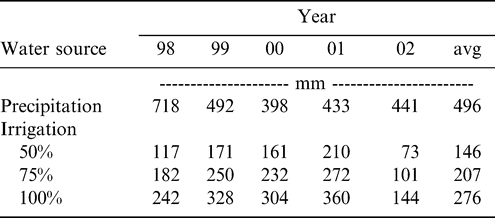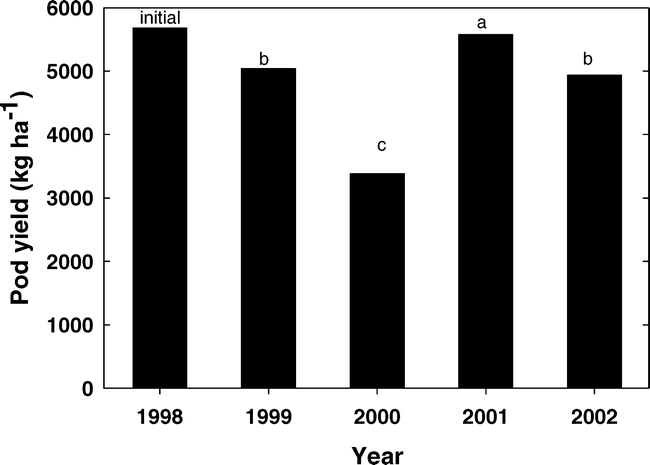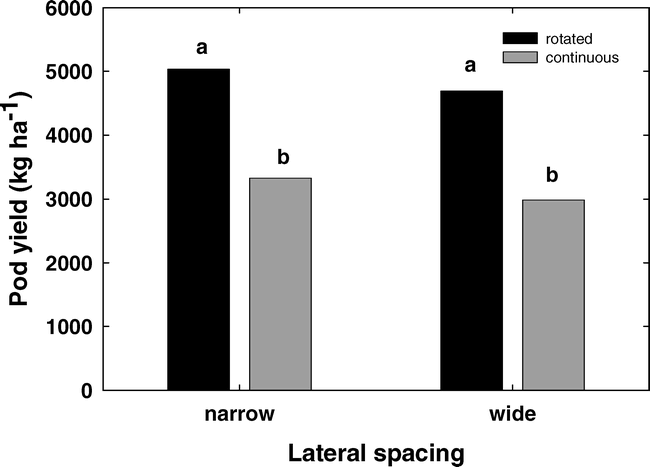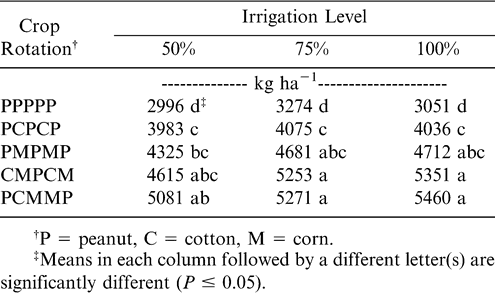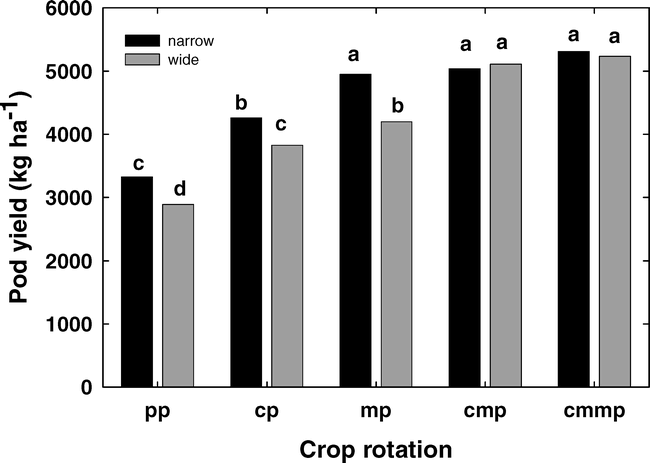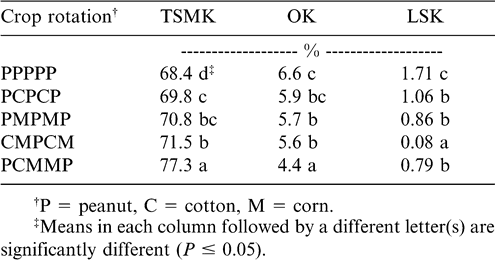Introduction
Peanut yield is greatly affected by the preceding crop and its management. Current best management practices (BMP) recommend peanut to be planted 1 out of 3 years (or longer), grass-type crops be grown prior to peanut, and the rotated grass-crop be well fertilized (Henning et al., 1982; Sholar et al., 1995). These BMP's have been established for irrigated areas typically using overhead irrigation (sprinkler) systems. Following these recommendations does not necessarily assure optimum crop yields, but yield reductions are minimized due to biological factors such as disease, nematodes, weeds, and other plant pests.
Over 1.2 million hectares are irrigated in Georgia, Florida, and Alabama, with 56% being irrigated with overhead irrigation systems (Anonymous, 1999). Peanut is raised on about 12% of the irrigated land in this tri-state region. In Georgia, peanut is grown on 23% of the irrigated land. Subsurface drip irrigation (SDI) systems are used on less than 6100 ha in the tri-state area, with most SDI systems used for vegetable production. It is unknown how many of these SDI systems are used to grow peanuts.
SDI has the potential to provide consistently high yields while conserving soil, water, and energy. Various researchers have shown that crop yield and quality can be increased using SDI on tomato, (Bogle et al., 1989; Camp et al., 1989), cotton (Bucks et al., 1988; Henggeler, 1988), and corn (Mitchell, 1981; Mitchell and Sparks, 1982; Powell and Wright, 1993). Other benefits include precise placement of water and chemicals, low labor requirements, and reduced runoff and erosion. These SDI systems have the capability of frequently supplying water to the root zone thereby reducing the risk of cyclic water stress typical of other irrigation systems. These SDI systems are adaptable to various field sizes and shapes making them an important consideration, especially in the southeast.
Increasing concern for water conservation in the tri-state region (Alabama, Georgia, and Florida) suggests the use of SDI due to the greater irrigation efficiency of these systems. The objectives of this research were to determine the long-term pod yield response of peanut to five crop rotations, two drip tube lateral spacings, and three irrigation regimens using subsurface drip irrigation.
Materials and Methods
The research site was located in Terrell County near Sasser, GA on a Tifton sandy loam soil (Fine-loamy, kaolinitic, thermic Plinthic Kandiudults) with 2–5% slope. A SDI system was installed in 1998 on non-irrigated farmland in a randomized split-split-design with three irrigation levels, five crop rotations, two drip tube lateral spacings, and three replications. Cotton had been planted two years prior to installing the SDI system. Land ownership had changed such that long term crop rotations were not available and the current owner had not raised peanut since 1993. A 6.8 ha area was divided into four equal areas referred to as tiers. There were alley-ways (12.2 m minimum) between tiers, at the sides, and crop row ends for equipment turn areas. Three tiers were used for the SDI irrigation treatments and one tier was assigned as a sprinkler treatment. Only the SDI system and treatments will be described. Each SDI tier (38 m by 274 m) was randomly assigned an irrigation level. A SDI tier consisted of three blocks (replications), five crop rotations, and two thin-wall drip lateral spacings for a total of 30 plots per tier. The irrigation levels were 100%, 75% and 50% of estimated crop water use (Sorensen et al., 2001).
The five crop rotations included continuous peanut (PPP), cotton-peanut (CP), corn-peanut (MP), cotton-corn-peanut (CMP), and a cotton-corn-corn-peanut (CMMP). All crops were planted on a 0.91 m row spacing planted in a single row orientation. The two drip tube lateral spacings had drip tubes installed underneath each crop row (narrow, 0.91 m) and in alternate crop row middles (wide, 1.83 m). Each narrow row subplot had six drip tube laterals installed under each row (6 crop rows) and was replicated three times across the tier. Each wide row subplot had five laterals installed in alternate crop row middles (10 crop rows) and replicated three times across the tier. Sorensen et al. (2001) describes in detail the treatments, irrigation system design criteria, and irrigation control. The thin-wall drip tube (Super Typhoon, Netafim Irrigation, Inc., Fresno, CA; www.netafim-usa.com) had a wall thickness of 0.254 ;mm (10 mil) and emitters spaced every 46 cm with a flow rate of 1.5 L h−1 per emitter. All thin-wall drip tubing was buried 31 to 36 cm deep using a modified ripper shank.
Irrigation water was applied daily based on replacement of estimated crop water use for peanut. Air temperature (maximum, minimum and average), total solar radiation, and precipitation were recorded daily. Daily potential evapotranspiration (ETo) was estimated using the modified Jensen-Haise equation adjusted for local conditions. Weekly crop coefficients, Kc, were determined by dividing the estimated weekly mean peanut water use (Stansell et al., 1976 and Harrison and Tyson, 1993) by the weekly estimated archived ETo data for the same time period. Daily ETo was then multiplied by the weekly Kc to estimate the daily water replacement for peanut (ET) which is identified as the 100% irrigation level. The other two irrigation levels were determined by multiplying the 100% irrigation level by 75% and 50%. Length of irrigation time for each irrigation treatment was calculated on estimated daily ET to apply the desired depth of water. Precipitation totals were subtracted from the estimated daily ET. Irrigation events were scheduled daily except when precipitation exceeded estimated ET.
Seed-bed preparation consisted of one or two passes with one piece of experimental tillage equipment that would essentially till the top 10 to 15 cm of soil then reshape the land into planting beds. This equipment provides the opportunity for controlled-traffic such that no wheeled equipment ran over the buried lateral positions. Since 1998, the peanut variety, “Georgia Green”, was planted between 10 to 16 May (depending on weather conditions) with a vacuum type planter (Monosem vacuum planter, ATI., Inc., Lenexa, KS; www.monosemplt.com) at about 20 seeds m−1 on a 0.91 m row spacing. Treatments in each respective year received the same weed, insect, and disease control management applications following general recommendations outlined by individual product manufacturer's or University of Georgia Agricultural Extension Service.
Harvest dates were based on the optimum crop maturity determined by the hull scrape method (Williams and Drexler, 1981). Yield rows (1.83 m by 38 m) were dug with a 2-row inverter and harvested with a 2-row combine. Sample weights were recorded and subsequently divided such that a 4 to 7-kg sub-sample was collected from each plot sample. Each sub-sample was graded and shelled to determine farmer stock grade and kernel size distribution, respectively. Pod yield was based on total sample weight adjusted to 7% moisture. Farmer stock grade and kernel size distribution were determined using procedures specified by the USDA (USDA, 1993).
Data were analyzed by using analysis of variance procedures for a split-split-plot design. Least significant difference range tests were used to show differences among means (tested at the P ≤ 0.05 level of probability) when ANOVA F-test showed significance.
Results and Discussion
Table 1 shows total water applied, yearly precipitation received, and average irrigation applied by water level for the five year period during the growing season (01 May to 30 Sept). Long term average precipitation typically received during this time is approximately 568 mm. These values show that during the years 1999 to 2002 much less precipitation was received than during the 1998 growing season. This time period, 1999 to 2002, was the extended drought that occurred across the southeast region. Only the 1998 growing season received greater than normal precipitation. Distribution of rain during any one year was variable. Rainfall in 2001 and 2002 were similar but rainfall patterns in 2002 were more evenly distributed during the growing season such that the number of irrigation events and total water applied was reduced.
Figure 1 shows the average yearly pod yield for peanut grown in rotation without respect to lateral spacing (continuous peanut excluded). Continuous peanut pod yields and individual crop rotations will be discussed later. The average pod yield for the five years was 4736 kg ha−1 for peanut in any of the four rotations. These data show that the initial year, 1998, had the greatest yield. The high initial year yield can be attributed to the higher than normal precipitation and the length of time since a peanut crop had been planted (1993). Also prior to land acquisition and installation of the drip system, extensive land preparation was performed by the owner. These rotation and land preparation factors along with proper irrigation and best management practices may have attributed to the high yield. Henning et al. (1982) recommended long rotations, good tillage practices, and good water for highest pod yields.
Average yearly pod yield of peanut for all crop rotations (excluding continuous peanut treatment), irrigation levels, and drip tube lateral spacings.Crop rotations were initiated in 1998; therefore 1998 data were excluded from data analysis. Different letters denote significant yield differences at the P ≤ 0.05.
The average pod yield decreased during 2000 with the onset of drought. Typically, the land was prepared about 2 to 4 weeks prior to planting using tillage equipment that tills the top 15 cm of top soil. A precipitation event usually occurs between tillage and planting that settles the soil. During 2000, there was very little precipitation (14 mm during the month of May) received between land preparation, planting, and emergence. We observed that water movement to the soil surface from the drip system essentially stopped at the tillage/non-tillage interface. In 2000, seed emergence and the resultant plant stand counts (data not presented) were lower than in other years. In 2001, we did a slightly different approach in that we tilled the land earlier in the year (mid March) in order to have a longer time period for precipitation to wet the soil. In addition, if precipitation events were not predicted prior to planting, a pre-plant irrigation of about 12 to 25 mm was applied. This allowed water movement to approach the soil surface. At planting, the top 5 to 8 cm was knocked off the top of the bed and seed was planted into moist soil. This worked well in both 2001 and 2002 as seed emergence was excellent (visual observations no data collected) and final pod yield were much higher than in 2000.
Table 2 shows analysis of variance probability values for pod yield, total sound mature kernels (TSMK), other kernels (OK), and loose shelled kernels (LSK) for all crop rotations including continuous peanut. These data show that crop rotation and lateral spacing significantly affects pod yield. Only crop rotation affected farmer stock grade parameters.
Figure 2 shows the average pod yield response by lateral spacing for rotated and continuous peanut. Comparisons between all rotations show that lateral spacing does have an effect on pod yield (Table 2). However, since continuous peanut is not a best management practice, removing continuous peanut from the analysis resulted in no difference in pod yield between lateral spacings (P = 0.169). Comparison between rotated versus continuous peanut by lateral spacing showed that rotated pod yield averaged 4737 kg ha−1 compared with the continuous peanut yield of 3107 kg ha−1. These data indicated that peanut pod yield can be increased by about 35% using crop rotations compared with continuous peanut. Continuous peanut irrigated with SDI had similar pod yield compared with the Georgia state yield average for irrigated peanut (Lamb et al. 1997). Even though continuous peanut is not a recommended agronomic practice, pod yield may be high enough that continuous peanut may be economically feasible depending crop market values and yield.
There was no yield difference between irrigation levels or irrigation level by lateral spacing interaction (Table 2). Average pod yield for all irrigation levels and lateral spacings was 4737 kg ha−1.
The interaction between drip tube lateral spacing and crop rotation was not significant (Table 2) for pod yield but was significant for TSMK and OK. Average peanut pod yield for the narrow and wide lateral spacings was 4882 and 4592 kg ha−1, respectively. Peanut irrigated at 50% with SDI had lower pod yield (4501 kg ha−1) compared with the 100% and 75% irrigated treatments (4890 and 4820 kg ha−1, respectively) implying a possible 25% water savings for the same yield. Simulated net returns for a specific grower could be compared to determine which drip tube spacing and irrigation level would be most economical for the grower.
Table 3 shows the yield response of the five crop rotations by irrigation level. Peanut planted in short-term rotations (alternate year) averaged 4302 kg ha−1 across all irrigation levels for both cotton-peanut and corn-peanut rotations. The two year rotation had higher peanut yield (5073 kg ha−1) than the average alternate year rotations (4302 kg ha−1). There was no yield difference between two and three year rotations which averaged 5172 kg ha−1 across all irrigation levels. Peanut yield was affected by previous crop and length of time between peanut crops.
Figure 3 shows the pod yield response of crop rotation compared with narrow and wide lateral spacings. These data show the yield of the narrow lateral spacing is numerically higher than the wide lateral spacing especially with alternate year rotations and with continuous peanut. While, these yield trends are not always significant (longer rotations between peanut), they do imply that a grower may need to consider installing drip tube laterals underneath every row instead of alternate row middles. The relationships between lateral spacing, crop yield and resultant economics still need to be determined with long term yield data. Longer rotations of two to three years between peanut averaged 5309 kg ha−1 for all drip tube lateral spacings and water levels. Pod yield increased over 900 kg ha−1 with a cotton-peanut (4236 kg ha−1) rotation compared with continuous (3322 kg ha−1) peanut (narrow tube lateral spacing). The corn-peanut rotation (4949 kg ha−1) had about 1627 kg ha−1 increase compared with continuous peanut (narrow drip tube lateral spacing). These pod yield data indicate that just one year between peanut crops, either cotton or corn, can increase pod yield an average 1270 kg ha−1 over continuous peanut. For highest peanut yield, the recommendation would be to plant corn in an alternate year rotation with peanut which would result in a 713 kg ha−1 pod yield increase compared with an alternate year cotton rotation. Jordan et al. (2002) showed just the opposite response with Virginia type peanut (NC 12C and NC 7) that peanut pod yield was higher with alternate year cotton than with alternate year corn in North Carolina. The discrepancy between these results could be explained by peanut variety or regional climatic differences. Projected yield and selling price of the alternate crop would dictate which crop for the grower to select.
Peanut pod yield response to narrow (0.91 m) and wide (1.83 m) lateral spacings with respect to various crop rotation treatments. Crop treatments are continuous peanut (PP), alternate year with cotton (CP), alternate year with corn (MP), two year rotation with cotton and corn (CMP), and a four year rotation with cotton and corn (CMMP). Different letters denote significant yield differences at the P ≤ 0.05.
Longer crop rotations (greater than one year between peanut crops) had just over a 580 kg ha−1 higher pod yield compared with the alternate year rotations. These data show that peanut yield increased with longer crop rotations, especially with a corn crop between peanut crops. These data coincide with existing recommendations established with overhead irrigation and nonirrigated production described by Henning et al. (1982) and Sholar et al. (1995).
Table 4 shows the average farmer stock (FS) grade for each crop rotation. The percentage of total sound mature kernels (TSMK) tended to increase and the percentage of other kernels (OK) tended to decrease as time between peanut crops increased. Overall, the best FS grade was for the longer rotations which had over an 9 percentage point increase in TSMK (77%) compared with continuous peanut (68%). The OK grade parameter showed an average 2.2 percentage point decrease with the rotated treatment (4.4%) compared with the continuous peanut treatment (6.6%).
Conclusions
The results from this research support current peanut best management practices for long crop rotation for higher yield when irrigated with SDI. These results also show that SDI can be used to irrigate peanut and maintain yield and grade similar to those reported for overhead irrigation systems. Longer time periods between peanut crops resulted in higher pod yields than with alternate year rotations. Peanut planted following corn in an alternate year rotation had higher pod yields than when following cotton. Continuous peanut had the lowest pod yield when compared to all other peanut rotations. There was no difference in pod yield by drip tube lateral spacing when comparing crop rotations. However, there was significant difference with drip tube lateral spacing when comparing continuous peanut with other crop rotations. There was no difference in pod yield between the 75 and 100% irrigation levels across all rotations and water levels. Peanut farmer stock grade decreased as time between peanut crops also decreased. The best pod yield and grade occurred at the 75% irrigation level with a narrow drip tube lateral spacing following a corn crop, either alternate or multiple years between peanut crops. Conversely the worst pod yield occurred at the 50% irrigation level, wide drip tube lateral spacing with continuous peanut.
Acknowledgements
The authors would like to thank Ilan Barr and Doug Davis of Netafim, USA, for their support of drip irrigation tubing, appurtenances, and engineering expertise to install and maintain the irrigation system.
References
Anonymous 1999 1998 annual irrigation survey. Irrigation Jour 49 : 28 – 38 .
Bogle C. R. , Hartz T. K. , and Nunez C. 1989 Comparison of subsurface trickle and furrow irrigation on plastic-mulched and bare soil for tomato production. J. Am. Soc. Hort. Sci 114 : 40 – 43 .
Bucks D. A. , Allen S. G. , Roth R. L. , and Gardner B. R. 1988 Short staple cotton under micro and level-basin irrigation methods. Irrig. Sci 9 : 161 – 176 .
Camp C. R. , Sadler E. J. , and Busscher W. J. 1989 Subsurface and alternate-middle microirrigation for the southeastern coastal plain. Trans. ASAE 31 / 2 : 451 – 456 .
Harrison K. A. and Tyson A. W. 1993 Irrigation scheduling methods. Coop. Ext. Bull. B-974 pp. 12 Cooperative Extension Service, The Univ. of GA College of Agric. and Environ. Sci Athens, GA .
Henning R. J. , Allison A. H. , and Tripp L. D. 1982 Cultural practices. 123 – 138 In Pattee H. E. and Stalker T. H. eds. Advances in Peanut Science Am. Peanut Res. and Educ. Soc Yoakum, TX .
Henggeler J. C. 1988 Drip irrigation: Lowering installation costs, increasing yields and improving water-use efficiency. 31 – 32 In Brown J. M. and Richter D. eds. Proc. 1988 Highlights of cotton production Res. Conf., Special Sessions: New Developments from Industry. 3–8 Jan. 1988, New Orleans Natl. Cotton Council of America Memphis, TN .
Jordan D. L. , Bailey J. E. , Barnes J. S. , Bogle C. R. , Bullen S. G. , Brown A. B. , Edmisten K. L. , Dunphy E. J. , and Johnson P. D. 2002 Yield and Economic Return of Ten Peanut-Based Cropping Systems. Agro. Journ 94 / 6 : 1289 – 1294 .
Lamb M. C. , Davidson J. I. , Childre J. W. , and Martin N. R. 1997 Comparison of peanut yield, quality, and net returns between nonirrigated and irrigated production. Peanut Sci 24 / 2 : 97 – 101 .
Mitchell W. H. 1981 Subsurface irrigation and fertilization of field corn. Agron. Journ 73 / 6 : 913 – 916 .
Mitchell W. H. and Sparks D. L. 1982 Influence of subsurface irrigation and organic additions on top and root growth of field corn. Agron Journ 74 / 6 : 1084 – 1088 .
Powell N. L. and Wright F. S. 1993 Grain yield of subsurface microirrigated corn as affected by irrigation line spacing. Agron. Journ 85 / 6 : 1164 – 1170 .
Sholar R. E. , Mozingo R. W. , and Beasley J. P. 1995 Peanut cultural practices. 354 – 382 In Pattee H. E. and Stalker T. H. eds. Advances in Peanut Science Am. Peanut Res. and Educ. Soc Stillwater, OK 614 pp .
Sorensen R. B. , Wright F. S. , and Butts C. L. 2001 Subsurface drip irrigation system design for research in row crop rotations. Appl. Eng. In Agric 17 / 2 : 171 – 176 .
Stansell J. R. , Shepherd J. L. , Pallas J. E. , Bruce R. R. , Minton N. A. , Bell D. K. , and Morgan L. W. 1976 Peanut responses to water variables in the southeast. Peanut Sci 3 / 1 : 44 – 48 .
United States Department of Agriculture 1993 Milled Peanuts: Inspection instructions U. S. Department of Agriculture, Agricultural Marketing Service, Fruit and Vegetable Division Washington, D. C .
Williams E. J. and Drexler J. S. 1981 A non-destructive method for determining peanut pod maturity. Peanut Sci 8 / 2 : 134 – 141 .
Notes
- 1Mention of proprietary product or company is included for the reader's convenience and does not imply any endorsement or preferential treatment by the USDA-ARS. [^]
- 2Research Agronomist, USDA-ARS-National Peanut Research Laboratory, Dawson, GA 39842. [^]
- 3Agric. Eng., USDA-ARS-National Peanut Research Laboratory, Dawson, GA 39842. [^]
- 4Plant Physiologist, USDA-ARS-National Peanut Research Laboratory, Dawson, GA 39842. [^] *Corresponding author: Dr. Ron Sorensen, USDA-ARS-National Peanut Research Laboratory, PO Box 509, 1011 Forrester Dr. SE, Dawson, GA 39842; 229.995.7411, fax: 229.995.7416: e-mail: rsorensen@nprl.usda.gov.


